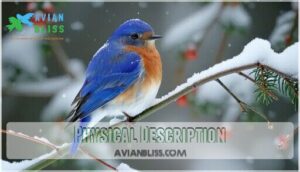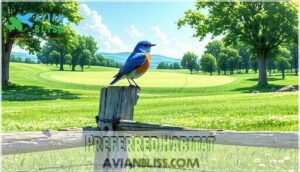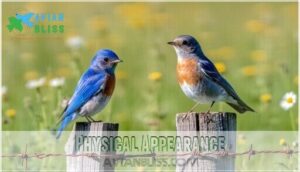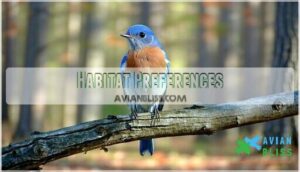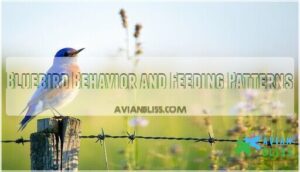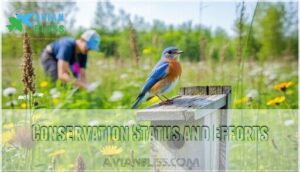This site is supported by our readers. We may earn a commission, at no cost to you, if you purchase through links.

These stunning songbirds display brilliant azure-blue upperparts with distinctive rusty-orange to brick-red breasts.
Males show more vibrant coloring than females, making identification straightforward.
Eastern Bluebirds feature deeper blue tones, while Western Bluebirds often have blue shoulders extending onto their backs.
Both species prefer open woodlands, farmlands, and suburban areas where they perch on fence posts hunting insects.
These medium-sized cavity nesters are symbols of happiness across North America.
Understanding their specific habitat preferences and seasonal behaviors can help you consistently spot these remarkable birds year-round.
Table Of Contents
- Key Takeaways
- Identifying Blue Birds With Red-Orange Chests
- Eastern Bluebird: Characteristics and Habitat
- Western Bluebird: Distinguishing Features
- Nesting Habits of Bluebirds
- Bluebird Behavior and Feeding Patterns
- Conservation Status and Efforts
- Symbolism and Cultural Significance of Bluebirds
- Tips for Attracting Bluebirds to Your Yard
- Frequently Asked Questions (FAQs)
- Which Bluebird has a red or orange chest?
- What birds have orange chests?
- How many types of bluebirds have orange chests?
- Why do blue birds have orange chests?
- How many blue-colored birds have orange under them?
- How many blue birds have orange on their chest or belly?
- Is the eastern bluebird rare?
- What states do Eastern Bluebirds live in?
- What is a bluebird with an orange chest?
- Is the Eastern Bluebird rare?
- Conclusion
Key Takeaways
- You’ll identify Eastern and Western Bluebirds by their brilliant blue backs combined with orange-red chests – males show more vibrant colors than females, with Eastern Bluebirds displaying deeper blue tones and Western Bluebirds featuring blue shoulders extending onto their backs.
- You’ll find these birds in open habitats like farmlands, golf courses, and suburban areas – they prefer spaces with scattered perches and short grass where they can easily spot insects from fence posts and utility wires.
- You can attract bluebirds to your yard by installing proper nest boxes and creating suitable habitat – mount boxes 4-6 feet high with predator guards, maintain open spaces with native plants, and avoid pesticides that eliminate their insect prey.
- You’re witnessing a conservation success story when you spot these birds – Eastern Bluebird populations have rebounded from near-extinction to 23 million individuals through dedicated nest box programs and habitat restoration efforts.
Identifying Blue Birds With Red-Orange Chests
When you spot a blue bird with a red or orange chest, don’t jump to conclusions about bird identification.
Lighting challenges can trick your eyes, making plumage variations appear different than they actually are. Eastern Bluebird and Western Bluebird share similar species characteristics, with geographic overlaps complicating identification.
Focus on habitat preferences and behavior patterns rather than color alone. Hybrid identification requires careful observation of size, bill shape, and tail length.
These blue birds prefer open spaces with perching spots, making them easier to study once you know where to look. These birds readily accept nest boxes for nesting.
Eastern Bluebird: Characteristics and Habitat
You’ll recognize the Eastern Bluebird by its royal blue back and wings paired with a vibrant orange-red throat and chest, though females display more muted tones.
This cavity-nesting species thrives in open habitats like meadows, fields, and golf courses where it can easily spot insects from perches, making it a great example of a bird that inhabits open habitats.
Physical Description
The Eastern Bluebird’s plumage details showcase stunning color variations that make bird identification straightforward.
Males display brilliant blue birds coloring across their backs, wings, and heads, contrasting with vibrant red or orange chest markings.
Female bird plumage appears more muted, with grayish-blue tones and softer orange breast coloring.
Their distinguishing features include compact 6.3-8.3 inch bodies, short straight bills, and distinctive white belly patches beneath the colorful chest.
These bird colors create unmistakable markings perfect for size comparison with other thrush species.
Preferred Habitat
Blue bird species with redorange chest features thrive in diverse habitat types across North America.
These birds prefer open country with scattered trees, where habitat diversity supports their insect-hunting lifestyle.
You’ll discover them in pastures, golf courses, and suburban parks where habitat fragmentation hasn’t eliminated suitable nesting sites.
Urban habitats increasingly accommodate these adaptable species, though climate impact and development pressure threaten traditional bird habitat preferences.
Habitat restoration efforts focus on maintaining the open woodlands these cavity nesters require.
- Golf courses provide ideal hunting grounds with short grass and scattered mature trees
- Suburban parks offer perfect habitat diversity with open spaces and wooded edges
- Rural pastures with fence posts create excellent perching spots for insect surveillance and habitat diversity supports their lifestyle.
Range
Looking across North America, you’ll discover Eastern Bluebirds inhabit an impressive range that spans from coast to coast.
These stunning blue bird species with red-orange chests adapt remarkably well to regional variations, making them accessible to birdwatchers everywhere.
Climate change has influenced their migration patterns, with some populations expanding northward while others face habitat overlap challenges.
Their breeding season range expands as they seek abundant food and nesting sites.
| Region | Status | Notable Features |
|---|---|---|
| Eastern US | Year-round resident | Stable populations, urban adaptation |
| Central Plains | Breeding season | Agricultural areas, nest box programs |
| Southern Canada | Summer visitor | Northern breeding limit, climate sensitivity |
Western Bluebird: Distinguishing Features
If you’re exploring western regions, you’ll encounter the Western Bluebird, which shares the Eastern Bluebird’s stunning blue and orange combination but displays distinct differences that help with identification.
The Western Bluebird features a deeper blue coloration on its back and wings, with males showing a rich chestnut patch across the shoulders that distinguishes them from their eastern cousins.
Physical Appearance
Distinguished by their enchanting plumage coloration, Western Bluebirds showcase brilliant blue heads, wings, and tails contrasting with rusty-orange chest feathers.
Sexual dimorphism creates notable size differences and color intensity variations between males and females. Juvenile plumage appears duller with spotted markings/patterns until maturity.
These blue birds with orange chest display remarkable bird color variations depending on lighting conditions and seasonal changes.
- Plumage intensity varies by age and sex
- Bird colors appear different under various lighting
- Chest coloration ranges from rust to deep orange
- Wing markings/patterns help distinguish individuals
Habitat Preferences
Western Bluebirds thrive in open woodlands with scattered trees and minimal ground cover.
These blue birds with orange chest markings prefer pine savannas, burned areas, and forest edges rather than dense Forest Habitats.
Unlike species favoring Urban Habitats or Wetland Habitats, Western Bluebirds seek Grassland Habitats and opencountry habitats where they can easily spot insects from perches.
Their bird habitat preference includes areas with moderate tree density that provide both nesting sites and hunting grounds for their insect-rich diet.
Geographic Distribution
Geographic distribution reveals fascinating patterns across Western Bluebird populations throughout western North America.
You’ll encounter these vibrant birds from southern British Columbia down to central Mexico, with their bird range extending eastward into parts of Texas and throughout the Rocky Mountains.
Regional variations in habitat preferences create distinct population clusters that demonstrate remarkable adaptability to diverse environments.
- Coastal populations inhabit mild Mediterranean climates along the Pacific shoreline
- Mountain residents thrive at elevations reaching 10,000 feet in coniferous forests
- Desert dwellers occupy arid landscapes where suitable nesting cavities exist
Migration patterns vary substantially across their bird distribution, with some populations remaining year-round residents while others undertake seasonal movements based on climate impact and resource availability.
Nesting Habits of Bluebirds
You’ll find that bluebirds are cavity nesters, meaning they build their homes in enclosed spaces like old woodpecker holes, natural tree cavities, or human-provided nest boxes.
During breeding season, which typically runs from March through August, these birds construct cup-shaped nests using grass, pine needles, and feathers, with females laying 3-7 pale blue eggs per clutch.
Nest Placement
Blue birds with orange chests select strategic nesting sites to maximize survival success.
Cavity Size determines accessibility, while Nest Height ranges from 5-50 feet depending on available options.
Material Selection focuses on secure, weatherproof locations in dead trees or artificial nest boxes.
Predator Avoidance drives placement away from ground threats, though Competition Impact from starlings affects site availability.
| Factor | Consideration |
|---|---|
| Height Range | 5-50 feet elevation |
| Cavity Preference | Natural holes, nest boxes |
| Tree Selection | Dead pines, oaks preferred |
| Predator Strategy | Elevated placement |
| Competition | Starlings, sparrows compete |
Nest Construction
Once placement is secured, bluebirds begin their fastidious construction process. These skilled architects gather nest materials including soft grasses, pine needles, and animal hair to line their cavity size homes.
The construction timeline spans 4-7 days, with females weaving cozy cups inside nest box design structures. Proper competition avoidance guarantees successful bird nesting outcomes. They often use sparrow-resistant nest boxes for safety.
Bird nesting behavior reveals fascinating construction patterns:
- Soft foundation layers create warmth that melts your heart
- Intricate weaving techniques showcase nature’s brilliant engineering
- Protective rim construction demonstrates devoted parental instincts
- Multiple bird nesting sites preparation shows their determined survival spirit
Understanding bird nesting habits and bird nest competition helps you support these remarkable builders in your backyard habitat.
Breeding Season
After nest construction, blue birds with orange chests enter their breeding season in early spring.
These dedicated parents follow a precise schedule:
- Mating rituals involve elaborate displays and territorial singing to attract mates
- Clutch size typically ranges from 3-7 eggs, with incubation period lasting 11-14 days
- Fledgling care extends 18-21 days as parents feed nestlings constantly
Blue birds demonstrate remarkable bird breeding efficiency, with some species raising multiple broods annually.
Their bird nesting habits showcase exceptional nestling development timing.
Bluebird Behavior and Feeding Patterns
You’ll find that understanding bluebird behavior patterns helps you identify these striking species and predict where they’ll appear in your yard.
These birds use specific foraging techniques and follow predictable feeding schedules that vary by season and habitat conditions, which is crucial for understanding their behavior.
Foraging Techniques
From fence posts and utility wires, you’ll watch bluebirds master their insect hunting techniques with remarkable precision.
These skilled hunters spot ground insects from 60 feet away, then swoop down using proven bird hunting techniques.
Their bird foraging strategy involves perching high, scanning open fields, and executing swift aerial maneuvers to catch prey mid-flight or pluck insects from grass.
Diet Composition
Understanding what drives their appetite helps you appreciate these colorful visitors better.
Bluebirds maintain remarkably diverse bird diets that shift with seasonal variation and availability.
Their insect consumption peaks during breeding season, while winter brings increased fruit intake.
These foraging strategies reflect their nutritional needs and demonstrate sophisticated prey selection:
- Caterpillars provide essential protein for growing chicks
- Beetles offer calcium vital for eggshell development
- Berries supply carbohydrates during cold months
- Flying insects showcase their aerial hunting skills
This bird diet influence on color comes from carotenoids in their prey, enhancing their vibrant plumage through strategic bird foraging habits.
Social Behavior
Blue birds with orange chests display complex flocking behavior during migration, traveling in small groups for protection.
Their mating rituals involve elaborate aerial displays and songs, while males establish territorial defense through aggressive posturing.
Communication signals include distinctive calls and wing movements that coordinate group activities.
Some species practice cooperative breeding, where previous offspring help raise new broods, demonstrating sophisticated bird social behavior patterns.
Conservation Status and Efforts
You’ll find that bluebird populations have faced significant challenges over the past century, with Eastern Bluebirds experiencing dramatic declines before recent recovery efforts.
Conservation programs, including nest box initiatives and habitat restoration projects, have helped stabilize populations and provide hope for these beloved species, highlighting the importance of conservation.
Population Trends
Against all odds, blue birds with orange chests have defied expectations through remarkable conservation successes.
Bird population trends show Eastern Bluebirds rebounding from near-extinction with populations increasing 2.4% annually since 1966.
Monitoring programs reveal these North American birds tripled in numbers between 1980-2004:
- Habitat loss reversed through nest box programs
- Climate change impacts mitigated by conservation efforts
- Urbanization impact reduced via bluebird trails
- Bird conservation initiatives supporting 20-23 million Eastern Bluebirds
- Western populations stable at 6.7-7.1 million individuals
This comeback story proves targeted conservation works.
The population trends were analyzed from 1966-1987.
Threats to Bluebirds
Despite population recovery, blue birds with orange chests still face significant threats.
Habitat Loss from urbanization and agriculture continues shrinking their nesting areas.
Invasive Species like European Starlings and House Sparrows aggressively compete for nest boxes, often destroying bluebird eggs.
Pesticide Use reduces insect prey while poisoning birds directly.
Climate Change disrupts breeding patterns and food availability.
Predation Risks from raccoons, snakes, and cats remain constant dangers, especially without proper nest box protection.
To mitigate these dangers, consider implementing predator control measures for nest boxes.
Conservation Initiatives
Fortunately, dedicated bird conservation organizations have launched thorough conservation initiatives to protect these stunning blue birds.
The North American Bluebird Society coordinates thousands of volunteers who monitor nest box programs across the continent, while habitat restoration projects focus on creating suitable environments near schools and prime locations.
- Nest Box Programs – Over 5,000 monitored boxes in California and 700 in Virginia produce thousands of fledglings annually
- Population Monitoring – Citizen scientists collect data weekly, contributing to research that guides conservation efforts
- Habitat Restoration – Rewilding projects restore open fields and woodland edges essential for nesting success
- Public Awareness – Educational campaigns distribute resources and fund live nest-cams for community engagement
These bird conservation efforts have shifted bluebirds from declining status to low conservation concern, with Eastern Bluebird populations increasing 2.4% annually since 1966.
Symbolism and Cultural Significance of Bluebirds
You’ll discover that bluebirds carry deep spiritual meanings across many cultures, often representing happiness, hope, and renewal in folklore and religious traditions.
These beautiful birds hold special significance in Native American legends, where they’re frequently viewed as messengers between the earthly and spiritual worlds, symbolizing transformation and the arrival of spring’s promise.
Spiritual Meanings
Throughout history, bluebird symbolism has represented profound spiritual guidance and divine messages across cultures.
These blue birds with orange chests embody hope and happiness, serving as powerful good omens in cultural beliefs worldwide.
| Culture | Symbolism | Meaning |
|---|---|---|
| Christianity | Divine messengers | Angelic presence, spiritual encouragement |
| Buddhism | Present-moment awareness | Mindfulness, daily gratitude |
| Chinese traditions | Celestial knowledge | Immortality, spiritual transformation |
| French folklore | Happiness symbol | Joy, positive change |
| Korean legends | Divine guidance | Protection, heavenly messages |
Their vibrant coloration connects to peace, tranquility, and contentment, while bird meanings emphasize renewal and positive transformation.
Dreams featuring these creatures signal resolution to struggles and remind you of life’s blessings.
Native American Legends
Native American creation stories paint bluebirds as sacred messengers carrying profound spiritual connections across tribal cultures.
These azure-winged creatures embody transformation, renewal, and divine communication in countless tribal variations throughout North America.
Bluebirds also symbolize the contentment and positivity that many seek.
- Iroquois legends describe bluebird songs driving away winter’s harsh spirits
- Navajo traditions connect bluebirds with dawn and daily spiritual renewal
- Pima creation stories tell of bluebirds transforming through magical blue lakes
- Pueblo mythology positions bluebirds as guardians of western directions
Tips for Attracting Bluebirds to Your Yard
You’ll want to create an environment that mirrors bluebirds’ natural preferences, focusing on open spaces with scattered perches and minimal pesticide use.
Success depends on combining proper nesting boxes, native plants that attract insects, and strategic placement of food sources during harsh weather periods.
Creating Suitable Habitat
Successfully attracting blue birds requires transforming your yard into their ideal habitat.
Create open spaces with scattered perches, maintain short grass areas, and plant native plants that naturally attract insects.
Install shallow water sources for drinking and bathing.
Avoid pesticides completely, as they eliminate the insects these birds need.
Planting native plants attracts insects that bluebirds rely on for food.
Add roosting shelters and implement predator control measures around bird feeders for ultimate bird watching success.
Providing Nesting Boxes
Install proper bird houses designed specifically for bluebirds to maximize your success rate.
Box Placement requires mounting at 4-6 feet high on poles with clear flight paths.
Consider these essential features:
- Choose Box Materials like cedar or pine with 1.5-inch entrance holes
- Install Predator Guards below mounting poles to protect nesting families
- Position bird house entries away from prevailing winds and direct sunlight
- Establish Box Maintenance schedules for cleaning between broods
Regular Monitoring Nests guarantees healthy occupancy while supporting nest box programs in your area.
You can find suitable bluebird house supplies online to help with bluebird house installation and maintenance, ensuring a successful nesting experience.
Offering Appropriate Food Sources
Success hinges on understanding bird diet preferences. Offer live mealworms as supplemental feeding – they’re irresistible to bluebirds.
During harsh winters, insect alternatives like suet cakes and native berries become essential winter food sources. Platform feeders work best since bluebirds rarely use traditional bird feeder designs.
Store bird food storage in cool, dry places. Proper nutrition can be supported with specialized avian products.
Understanding these bird feeding habits and providing appropriate bird diet supplements alongside natural foods creates an attractive buffet.
Frequently Asked Questions (FAQs)
Which Bluebird has a red or orange chest?
The Eastern Bluebird displays a vibrant orange-red chest and throat, while the Western Bluebird features rusty-orange coloring on its chest, making both species easily distinguishable from their blue plumage.
What birds have orange chests?
You’ll spot orange-chested birds like Eastern Bluebirds, Barn Swallows, Red-breasted Nuthatches, American Robins, and Baltimore Orioles.
These species display varying shades of orange, from soft rust to vibrant tangerine across their breast feathers, showcasing a range of colors that include tangerine.
How many types of bluebirds have orange chests?
Two bluebird species sport orange chests: Eastern and Western Bluebirds.
You’ll find males displaying vibrant blue backs with striking orange breasts, while females show more muted coloring for camouflage during nesting season.
Why do blue birds have orange chests?
Blue birds develop orange chests through sexual dimorphism and species-specific plumage patterns that aid in mate attraction, territorial displays, and species recognition.
You’ll find this coloration helps distinguish males from females during breeding season, which is a result of species-specific characteristics.
How many blue-colored birds have orange under them?
Several blue birds display orange or reddish chest coloration.
You’ll find this combination in Eastern Bluebirds, Western Bluebirds, Lazuli Buntings, Red-breasted Nuthatches, and Barn Swallows—each showing unique variations of blue backs with warm orange underparts.
How many blue birds have orange on their chest or belly?
Based on the provided information, you’ll find six blue birds with orange on their chest or belly: Eastern Bluebird, Western Bluebird, Lazuli Bunting, Red-breasted Nuthatch, Barn Swallow, and Belted Kingfisher females display this striking color combination.
Is the eastern bluebird rare?
Eastern bluebirds aren’t rare today.
Partners in Flight estimates a global breeding population of 23 million, and they’re considered a species of low conservation concern.
They’ve bounced back from severe population declines in the mid-20th century, which is a notable recovery.
What states do Eastern Bluebirds live in?
You’ll find Eastern Bluebirds across most of the eastern United States, from southern Canada down to the Gulf Coast and into parts of the Southwest.
They are adapting to various open habitats year-round.
What is a bluebird with an orange chest?
Beauty is in the eye of the beholder," and you’re likely spotting an Eastern Bluebird.
This stunning songbird displays brilliant blue upperparts with a warm orange-rust chest and throat, making it one of North America’s most recognizable species.
Is the Eastern Bluebird rare?
No, the Eastern Bluebird is considered a species of low conservation concern today.
While the species became rare in parts of its range during the early to mid-20th century, conservation efforts helped them rebound to 22 million individuals globally, which is a significant rebound.
Conclusion
Beautifully blue birds bearing red-orange chests bring remarkable rewards to backyard birdwatchers.
You’ll confidently identify Eastern and Western Bluebirds using their distinctive coloration patterns, habitat preferences, and behavioral characteristics.
These cavity-nesting songbirds require specific environmental conditions, making proper habitat management essential for successful observation.
Creating suitable nesting opportunities through appropriate box placement and maintaining open foraging areas will attract these stunning species to your property.
Remember that each blue bird red orange chest sighting represents a conservation success story worth celebrating and protecting.
- https://en.wikipedia.org/wiki/Lazuli_bunting
- https://www.chesterzoo.org/schools/resources/passerine-vs-non-passerine/
- https://www.lyricbirdfood.com/birding-hub/basics/the-juvenile-stage-what-happens-when-baby-birds-leave-the-nest/
- https://www.nwf.org/Garden-for-Wildlife/Young/Nesting-Box
- https://granger.wbu.com/bluebird-fun-facts-2023mch

